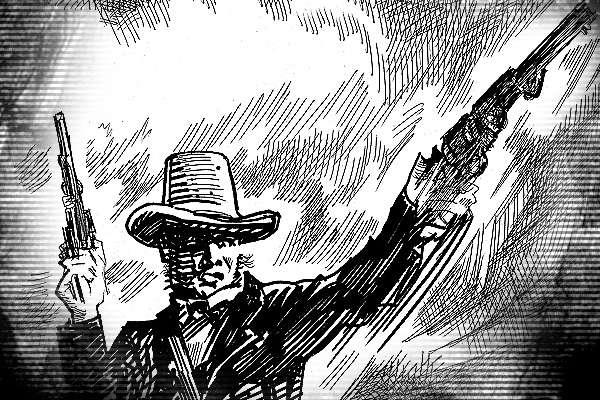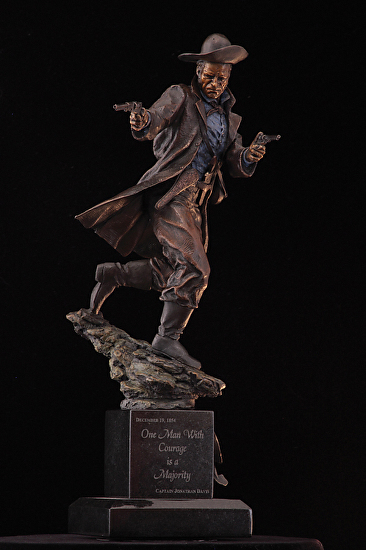
Armed Prospector
Born in Monticello, South Carolina on August 5, 1816, Davis grows up learning how to ride, shoot, and use bladed weapons, while his mental acuity is honed and improved with his attendance at the University of South Carolina in Columbia, where he becomes a member of the school's Euphradian Society (a literary society established in 1806, also known as Phi Alpha Epsilon). Trouble on America's southern border in 1846, at 30 years of age, Davis volunteers to become a member of South Carolina's Palmetto Regiment, 10 companies of men, comprised of members of the U.S. Regular Army and state volunteers answering President James K. Polk's call to arms against Mexico. Gathered together in Charleston, the men receive training from the cadets of the Military College of South Carolina, now known as The Citadel. On the day before Christmas, December 24, 1846, the regiment receives its colors, a flag made of blue silk with the Coat of Arms of South Carolina on one side, and a palmetto tree on its other side, with wording that reads, "Presented by the City of Charleston" and the motto "Not for ourselves we conquer, but our country" (at the September of 1847 Battle of Chapultepec, it will become the first American colors to be raised over Mexico City). Part of Major General Winfield "Old Fuss and Feathers" Scott's army of invasion, Davis is made an honorary captain in the regiment and sees action from the time he lands at the port of Vera Cruz to the army's capture of Mexico City. Serving with distinction, at the August 20, 1847, Battle of Churubusco (a clash that sees six different men, ranging from Colonel Pierce Mason Butler down to Private Patrick Leonard carry the flag into action), Davis is wounded but survives the war. Healed and mustered out of South Carolina's service, in 1854, Davis decides to try his hand at gold mining in the Sierra Nevada Mountains of California.

President Polk
General Scott
Forward At Churubusco
Gold discovered by John W. Marshall at Sutter's Mill on January 24, 1848, the influx of thousands of men, women, and children results in California, by way of the Compromise of 1850, becoming a free state. the Union's 31st state, on September 9, 1850. But on the edge of civilization, bad apples, of the human sort, abound. Using the remoteness of the high peaks of the Sierras for cover, an international gang of fourteen murderous thieves, consisting of two Americans, one Frenchman, two Britons, four Mexicans, and five former Sydney Ducks (a gang of criminal transplants from Sydney, Australia that causes San Francisco to engage in its first bouts of vigilante justice) terrorizes the area. Leaving no witnesses to their crimes alive, two days before, the bandits robbed and killed six Chinese miners, and the previous day, four American prospectors suffered the same fate (the take in the killings includes $491 in silver and gold coins, four ounces of gold dust, two silver watches and seven gold timepieces). Set up and ready again for a third day of ambush mayhem and murder, their next targets are a group of three men walking up a rugged mining trail through Rocky Canyon near the Todd Valley on the Middle Fork of California's American River, not far from the growing community of Sacramento ... Doctor Bolivar Sparks, prospector James McDonald, and Captain Jonathan R. Davis.
Marshall
Growing San Francisco - 1851
Middle Fork
No warning given, the gang rises from its hiding places in the brush along the trail and opens fire on the three prospectors ... McDonald is cit down without even being able to pull his pistol, while Doctor Sparks gets off two crook missing hasty rounds before he too goes to the ground (taken off the mountain, the doctor will die on the 26th of the month, at his home in the town of Coloma). Focus totally on survival, keeping his calm as the chaos sweeps over him, Davis pulls two, ball-and-cap Colt .45 revolvers and begins whirling about in what the war veteran will describe as a "fever of excitement," firing at one target after another, until bullets expended, seven outlaws lay dead or mortally wounded. But there are more bad guys attacking and a new band of four killers rushes at Davis with Bowie knives and a cutlass ... a new threat that Davis meets by pulling his own knife and demonstrating his death dealing skills extend beyond pistols. Stab parried and counter thrust made, Davis kills his first attacker, disarms his second attacker by a blade hit that causes his opponent to drop his weapon and flee, minus the nose on his face and fingers on his hand (bleeding wounds that the badman will eventually die from), then in short order stabs to death two more attackers. Though they still have a number advantage on Davis, seeing how that advantage hasn't really worked out too well for their criminal confederates, the final three men flee into the wildness, the captain has triumphed over fourteen adversaries, killing or mortally wounding eleven of them in seconds!
Colt .45

Davis - True West Illustration
Fight over, ignoring his own wounds (Davis has been grazed twice, and his clothes have been holed over a dozen times, including six bullets through his hat), the captain tears strips from his shirt to try and bind the doctor's wounds, and those of the wounded outlaws. He finally receives help when three miners, John Webster, Isaac Hart, and P.S. Robertson, who have witnessed the entire fight from the other side of the canyon arrive on the scene (still in fight mode, Davis will call to them to "Halt" when they arriving, covering them with the fallen McDonald's gun until he knows who the men are). Three months later, when some begin to doubt the validity of the tales being told about the fight, in the office of Placerville Mountin Democrat newspaper (the story will be told in the California Chronicle of San Francisco and New York City's Knickerbocker Magazine), before a judge and a group of prominent citizens, the men and Davis given written and verbal depositions about the battle (Davis will state, "I did what hundreds of others have dne under similar circumstances, and attach no particular credit to myself for it."). Story believed, Davis goes on to living a long, peaceful life in California ... in 1855 he is on a coroner's jury in the town of Sonora, in 1865 he is brokering cattle in Napa County, in 1875 Davis is listed as a sixty-year-old miner in Scott Valley, in the 1877 register of citizens, Trinity County lists him as a lawyer, at 64 he is in Weaverville, at 68 he is a member of the populace of Shasta Township, and before his death (date and cause unknown), there are stops in the town of Yount and San Joaquin County (1890) No known photo of Davis available, the man nevertheless lives on ... his tale is rediscovered in the 1980's by author Bill Secrest Sr., and told again, immortalized by artist Mike Trcic's sculpture of the captain, "One Man With Courage Is A Majority" ... INDEED!

Statue Tribute
.
No comments:
Post a Comment